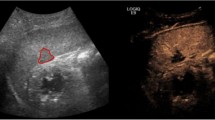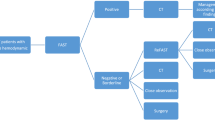Abstract
Our objective is to underline the place of FAST (focus assessment by sonography for trauma) ultrasonography (US) in the investigation of blunt abdominal trauma. We retrospectively examined the ultrasound findings in 1,999 haemodynamically stable adult patients. These people were admitted to the emergency room (ER) for possible blunt abdominal trauma. All were stable at admission and a FAST ultrasound examination was made. Initial findings were compared with the clinical course after at least 24 h of observation time and CT results. Among the 1,999 US examinations, abnormalities were found in 109 (5.5%) cases. Among them, 102 had free peritoneal fluid, and in 58 examinations, ruptures, lacerations or haematomas were demonstrated. Despite its limitations, such as in cases involving uncooperative patients, excessive bowel gas, obesity and empty bladder, the FAST technique seems to be an accurate method to evaluate the possibility of abdominal blunt trauma in stable patients. Because of the high negative predictive value of the FAST technique in stable patients with blunt abdominal trauma, we recommend that a stable patient with negative ultrasound results at admission remain under close observation for at least 12 or preferably 24 h before being discharged.


Similar content being viewed by others
References
Powell DC, Bivins BA, Bell RM (1982) Diagnostic peritoneal lavage. Surg Gynecol Obstet 155:257–264
Day AC, Rankin N, Charlesworth P (1992) Diagnostic peritoneal lavage: integration with clinical information to improve diagnostic performance. J Trauma 32:52–57
McKenney M, Lentz K, Nunez D et al (1994) Can ultrasound replace diagnostic peritoneal lavage in the assessment of blunt trauma? J Trauma 37:439–441
Richards JR, Berlet RW (1998) Computed tomography for blunt abdominal trauma in the ED: a prospective study. Am J Emerg Med 16:338–342
Mirvis SE, Whitley NO, Vainwright JR, Gens DR (1989) Blunt hepatic trauma in adults: CT-based classification and correlation with prognosis and treatment. Radiology 171:27–32
Kinnunen J, Kivioja A, Poussa K et al (1994) Emergency CT in blunt abdominal trauma of multiple injury patients. Acta Radiol 35:319–322
Jehle D, Guarino J, Karamanoukian H (1993) Emergency department ultrasound in the evaluation of blunt abdominal trauma. Am J Emerg Med 11:342–346
Rothlin MA, Naf R, Amgwerd M et al (1993) Ultrasound in blunt abdominal and thoracic trauma. J Trauma 34:488–495
McGahan JP, Rose J, Coates TL, Wisner DH, Newberry P (1997) Use of ultrasonography in the patient with acute abdominal trauma. J Ultrasound Med 16:653–662
Kimura A, Otsuka T (1991) Emergency center ultrasonography in the evaluation of hemoperitoneum: a prospective study. J Trauma 31:20–23
Rozycki GS, Ochsner MG, Jaffin JH, Champion HR (1993) Prospective evaluation of surgeons’ use of ultrasound in the evaluation of trauma patients. J Trauma 34:516–526
McKenney MG, Martin L, Lentz K et al (1996) 1,000 consecutive ultrasounds for blunt abdominal trauma. J Trauma 40:607–610
Huang MS, Liu M, Wu JK, Shih HC, Ko TJ, Lee CH (1994) Ultrasonography for the evaluation of hemoperitoneum during resuscitation: a simple scoring system. J Trauma 36:173–177
Brown MA, Casola G, Sirlin CB, Patel NY, Hoyt DB (2001) Blunt abdominal trauma: screening US in 2,693 patients. Radiology 219:352–358
Richards JR, Schleper NH, Woo BD, Bohnen PA, McGahan JP (2002) Sonographic assessment of blunt abdominal trauma: a 4-year prospective study. J Clin Ultrasound 30:59–67
Melanson SW, Heller M (1998) The emerging role of bedside ultrasonography in trauma care. Emerg Med Clin North Am 16:165–189
McGahan JP, Richards J, Gillen M (2002) The focused abdominal sonography for trauma scan. Peals and pitfalls. J Ultrasound Med 21:789–800
Pearl WS, Todd KH (1996) Ultrasonography for the initial evaluation of blunt abdominal trauma: a review of prospective trials. Ann Emerg Med 27:353–361
Rose JS, Levitt MA, Porter J et al (2001) Does the presence of ultrasound really affect computed tomographic scan use? A prospective randomized trial of ultrasound in trauma. J Trauma 51:545–550
Lee BC, Ormsby EL, McGahan JP et al (2007) The utility of sonography for the triage of blunt abdominal trauma patients to exploratory laparotomy. AJR 188:415–421
Nunes LW, Simmons S, Hallowell MJ, Kinback R, Trooskin S, Kozar R (2001) Diagnostic performance of trauma US in identifying abdominal or pelvic free fluid and serious abdominal or pelvic injury. Acad Radiol 8:128–136
Shanmuganathan K, Mirvis SE, Sherbourne CD, Chiu WC, Rodriguez A (1999) Hemoperitoneum as the sole indicator of abdominal visceral injuries: a potential limitation of screening abdominal US for trauma. Radiology 212:423–430
Dolich MO, McKenney MG, Varela JE, Compton RP, McKenney KL, Cohn SM (2001) 2,576 ultrasounds for blunt abdominal trauma. J Trauma 50:108–112
Richards JR, McGahan JP, Simpson JL, Tabar P (1999) Bowel and mesenteric injury: evaluation with emergency abdominal US. Radiology 211:399–403
Poletti PA, Kinkel K, Vermeulen B et al (2003) Blunt abdominal trauma: should US be used to detect both free fluid and organ injuries? Radiology 227:95–103
McGahan P, Horton S, Gerscovich EO et al (2006) Appearance of solid organ injury with contrast-enhanced sonography in blunt abdominal trauma: preliminary experience. AJR 187:658–666
McKenney KL, Nunez DB, McKenney MG, Asher J, Zelnick K, Shipshak D (1998) Sonography as the primary screening technique for blunt abdominal trauma: experience with 899 patients. AJR Am J Roentgenol 170:979–985
Bakker J, Genters R, Mali W, Leenen L (2005) Sonography as the primary screening method in evaluating blunt abdominal trauma. J Clin Ultrasound 33:155–163
Marco GG, Diego S, Luca S (2005) Screening US and CT for blunt abdominal trauma: a retrospective study. Eur J Radiol 56:97–101
Sirlin CB, Brown MA, Andrade-Barreto OA (2004) Blunt abdominal trauma: clinical value of negative screening US scans. Radiology 230:661–668
Miller MT, Passquale MD, Bromberg WJ et al (2003) Not so FAST. J Trauma 54:59–60
Stengel D, Bauwens K, Sehouli J et al (2005) Emergency ultrasound-based algorithms for diagnosing blunt abdominal trauma. Cochrane Database Syst Rev 2005:e18
Griffin XL, Pullinger R (2007) Are diagnostic peritoneal lavage or focused abdominal sonography for trauma safe screening investigations for hemodynamically stable patients after blunt abdominal trauma? A review of the literature. J Trauma 62:779–784
Author information
Authors and Affiliations
Corresponding author
Rights and permissions
About this article
Cite this article
Kornezos, I., Chatziioannou, A., Kokkonouzis, I. et al. Findings and limitations of focused ultrasound as a possible screening test in stable adult patients with blunt abdominal trauma: a Greek study. Eur Radiol 20, 234–238 (2010). https://doi.org/10.1007/s00330-009-1516-1
Received:
Revised:
Accepted:
Published:
Issue Date:
DOI: https://doi.org/10.1007/s00330-009-1516-1




